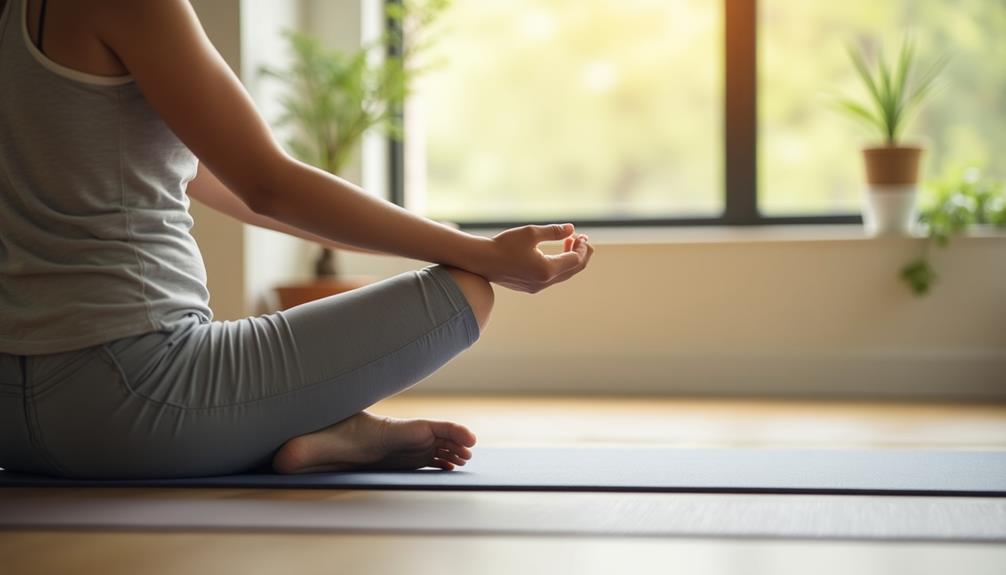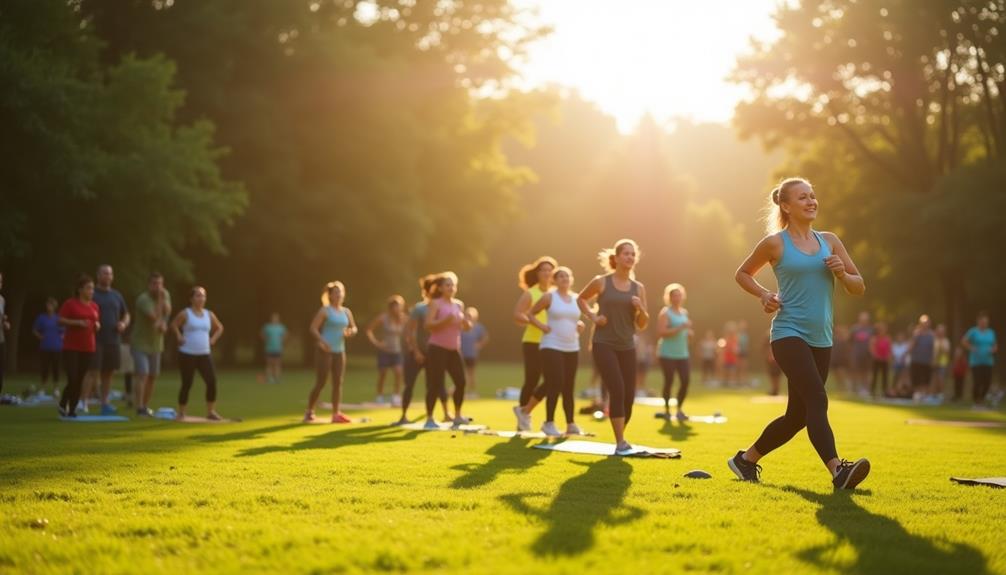To reduce muscle soreness through active recovery, try these seven tips. First, incorporate light stretching to boost blood flow and flexibility. Next, engage in low-impact exercises, like walking, cycling, or swimming, for 20-30 minutes several times a week. Don't forget to stay hydrated, aiming for at least 64 ounces of water daily. Utilize foam rolling to release muscle knots and improve flexibility. Additionally, practice deep breathing to enhance oxygen flow and promote relaxation. Gentle yoga can also aid your recovery, along with prioritizing quality sleep each night. There's much more to discover about effective techniques for recovery.
Core Insights
- Incorporate light stretching post-workout to enhance flexibility and reduce muscle soreness by increasing blood flow to the muscles.
- Engage in low-impact exercises like walking, cycling, or swimming to minimize muscle soreness while promoting recovery.
- Stay hydrated by drinking at least 64 ounces of water daily to aid muscle recovery and flush out toxins.
- Utilize foam rolling for 5-10 minutes to improve recovery by breaking down muscle knots and enhancing blood flow.
- Practice deep breathing techniques to increase oxygen flow to muscles, helping to reduce soreness and promote relaxation.
Incorporate Light Stretching

After a workout, incorporating light stretching can greatly help reduce muscle soreness. Stretching increases blood flow to your muscles, promoting recovery. It also enhances flexibility, preventing stiffness. Begin with gentle stretches that target the major muscle groups you've used during your workout. For those dealing with specific injuries or chronic pain, targeted relief options like cold therapy compression wraps can complement your stretching routine for enhanced recovery.
Focus on holding each stretch for about 15-30 seconds. Don't rush this process; it's important to breathe deeply and relax into each stretch. You might try static stretches for your legs, arms, or back.
Avoid bouncing, as this can lead to injury. Instead, aim for controlled movements. By making stretching a regular part of your routine, you'll not only reduce soreness but also improve your overall performance and range of motion. So take the time to stretch; your body will thank you!
Try Low-Impact Exercises

Incorporating low-impact exercises into your routine can further aid in reducing muscle soreness while promoting recovery. These exercises, such as walking, cycling, or swimming, put less strain on your joints and muscles. They help maintain blood circulation, delivering essential nutrients to sore areas. Foam rollers can also be effective tools for myofascial release, enhancing flexibility and reducing muscle tension when used in conjunction with low-impact activities.
Aim for 20 to 30 minutes of low-impact activity a few times a week. This can enhance your overall endurance without exacerbating soreness.
Additionally, consider activities like yoga or Pilates, which focus on flexibility and core strength. These not only provide gentle movement but also improve your range of motion.
Stay Hydrated

Staying hydrated is essential for minimizing muscle soreness and aiding recovery. When you're well-hydrated, your body can efficiently transport nutrients to your muscles and flush out toxins. This helps reduce inflammation and promotes healing.
Here's a quick reference for hydration:
| Activity | Recommended Water Intake |
|---|---|
| Light exercise | 8-10 ounces (240-300 ml) |
| Moderate exercise | 12-16 ounces (360-480 ml) |
| Intense exercise | 16-24 ounces (480-720 ml) |
| Post-exercise | 16-24 ounces (480-720 ml) |
| Daily hydration goal | At least 64 ounces (1.9 L) |
Make it a habit to drink water throughout the day. This simple practice can greatly enhance your recovery process and keep muscle soreness at bay.
Utilize Foam Rolling

Hydration alone won't completely prevent muscle soreness; incorporating foam rolling into your routine can greatly improve recovery. Foam rolling helps break down knots in your muscles, increasing blood flow and flexibility. For an added cooling effect, consider using a cooling towel during your recovery sessions to help reduce inflammation. Start by selecting a foam roller that suits your needs—high-density options provide more pressure, while softer rollers are gentler.
To use it effectively, roll slowly over the sore areas, pausing on tight spots for 20-30 seconds. Aim for 5-10 minutes of rolling after your workout or on rest days. You can target major muscle groups like quads, hamstrings, and calves. Regular foam rolling can reduce soreness and speed up recovery, allowing you to feel better and perform at your best. Make it a habit for best results!
Practice Deep Breathing

Many people underestimate the power of deep breathing when it comes to reducing muscle soreness. This simple practice can help your body relax and promote recovery. When you focus on your breath, you increase oxygen flow to your muscles, aiding in healing and reducing discomfort.
To practice deep breathing, find a comfortable position. Inhale deeply through your nose, allowing your abdomen to expand. Hold that breath for a moment, then exhale slowly through your mouth. Repeat this process several times, aiming for a steady rhythm.
Incorporating deep breathing into your routine can enhance your overall recovery experience. By managing stress and promoting relaxation, you'll not only feel better physically but also mentally, making it a valuable tool in your active recovery toolkit.
Engage in Gentle Yoga

Start with basic poses like Child's Pose or Cat-Cow. These positions gently stretch muscles and encourage relaxation. Focus on your breath, allowing it to guide your movements.
Aim for a short session, around 20 minutes, a few times a week. This consistency can notably impact your overall recovery.
Prioritize Quality Sleep

Getting enough quality sleep is essential for reducing muscle soreness and aiding recovery. When you sleep, your body repairs tissues and builds muscle, which helps alleviate soreness. Aim for 7-9 hours of uninterrupted sleep each night.
To improve sleep quality, establish a consistent sleep schedule. Go to bed and wake up at the same time every day, even on weekends. Create a relaxing bedtime routine by winding down with activities like reading or gentle stretching.
Limit screen time before bed, as blue light can disrupt your sleep cycle. Make your sleep environment comfortable by keeping it cool, dark, and quiet. By prioritizing quality sleep, you'll enhance your recovery process and reduce muscle soreness effectively.
Frequently Asked Questions
How Soon After Exercise Should I Start Active Recovery?
You should start active recovery within 24 hours after exercising. Engaging in light activities, like walking or stretching, helps your muscles recover faster and reduces soreness, ensuring you feel better sooner and stay motivated.
Can Active Recovery Reduce Soreness After Intense Workouts?
Active recovery can zap away that post-workout soreness like a superhero swooping in. You'll feel your muscles thanking you as you stretch, walk, or do light activities, helping them bounce back faster than ever!
Is There a Specific Duration for Active Recovery Activities?
There isn't a one-size-fits-all duration for active recovery; however, aiming for 20 to 30 minutes of light activity, like walking or cycling, can effectively enhance recovery and reduce muscle soreness after intense workouts.
What Should I Eat for Optimal Muscle Recovery?
Think of your muscles as sponges, thirsty for nutrients. For best recovery, you'll want lean proteins, whole grains, and plenty of fruits and veggies. Hydration's key too—don't forget to drink water throughout the day!
How Often Should I Incorporate Active Recovery Into My Routine?
You should incorporate active recovery into your routine at least once or twice a week. This keeps your muscles engaged, promotes blood flow, and helps you feel more refreshed while reducing soreness from your workouts.

